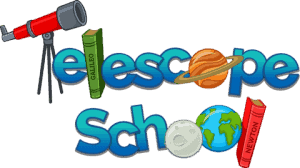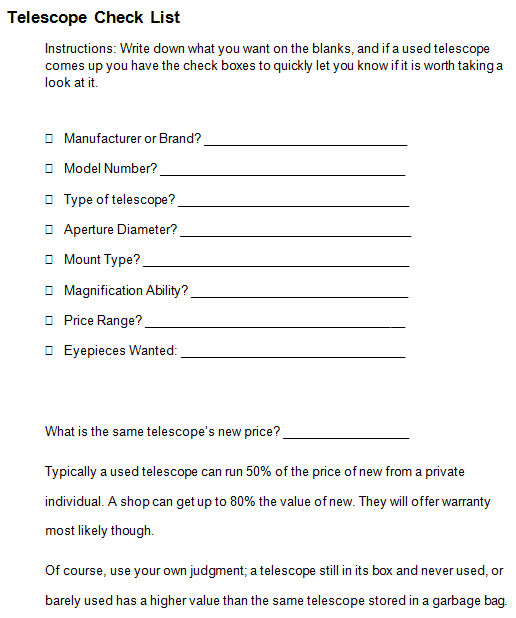There are a lot of marketing hypes which might lead you to buy the wrong telescope for your needs. Why not save some cash first by finding a good previously owned (used) telescope.
In general, there are two vital factors in choosing the right telescope: stable and smooth adjustments on the mount and good to excellent optic quality. Likewise, you need to choose a telescope that provides a convenience with use and portability to your individual need.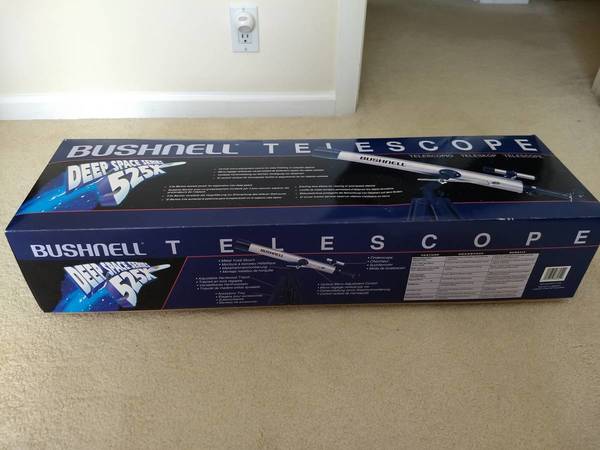
There is no such thing as a perfect telescope, especially when the atmosphere can get in the way, but knowing the essential features and factors you need to look for will ensure a best chance of buying the right scope for you.
So, if you are looking for a used telescope, the main reason is most likely budget. But you should know what you want out of the scope before you purchase. What does that mean?
I can answer that question with a couple more questions. Do you want to look at the moon? Do you want to see Saturn and its rings? Do you want to do astrophotography on deep space objects (DSO’s)?
Well, if you can answer those questions, you are on your way to knowing what telescope you need. We will break it down further as you move forward and put a quick checklist to assist you near the end. Let’s go!
What Style Telescope Should I Get?
Today, there are several types of scopes sprouting in the market, and this makes the whole choosing and buying process even more challenging. Here, we will narrow it down to three main types: Refracting, Reflecting, and Compound or Catadioptric telescopes.
The choice of which type to select dramatically depends on your current need and situation. Just make sure to consider your place, the aperture, mount, and price. There are things to admire and gripe for each type of telescopes, and you need to know these things before making a decision.
Refractors
This type of scope uses lenses in its optical system. For you to gauge its worth, let us outline the benefits and setbacks from this type.
Pros:
- It is simple and easy to use.
- Compared to reflecting scopes, this type does not experience misalignment with its optics.
- The overall construction of this type is sturdy and resistant to external shocks and bumps.
- It produces better image quality.
- Has a high state of maintaining clear imaging over time.
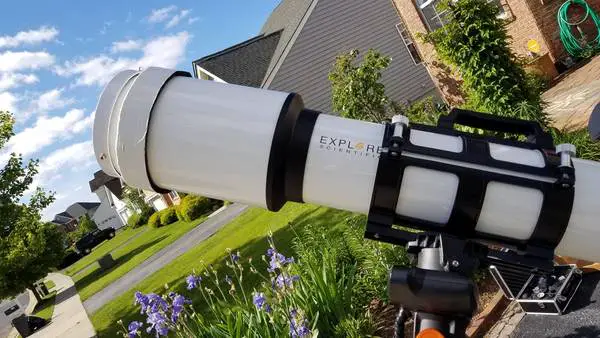
Cons:
- They are less portable, particularly if the objective lens has a long focal length or large aperture because of weight and size.
- This type of scope can have problems with chromatic aberrations where the light coming from the object spreads into a rainbow effect when viewed through the scope.
- Most of these units have a slightly higher upfront cost because of the cost of manufacturing the lenses.
Reflectors
This type of telescope uses mirrors instead of lenses and is also called the Newtonian scope. A reflecting telescope is mostly preferred for those starting out in their observational astronomy hobby. Dobsonian’s fall in this category as well.
For you to get a better gauge on this type, below are its pros and cons.
Pros:
- Because it uses mirrors instead of lenses, it does not suffer from chromatic aberration.
- They have lesser upfront cost compared to refractors because mirrors are cheaper to manufacture than lenses.
- The bigger reflectors are much cheaper compared to its refractor of equal aperture. Around 100mm, you start seeing refractor prices step higher than a reflector.
- They also incorporate cost-efficient design.
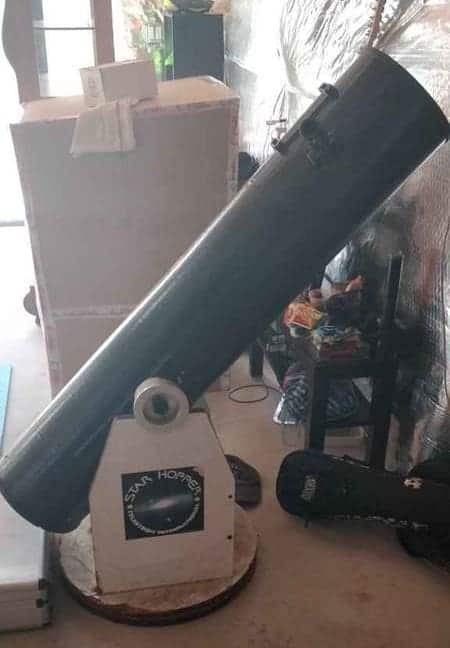
Cons:
- There are instances where the secondary mirror of a reflecting telescope blocks the light being gathered and redirected toward the eyepiece.
- The common issue among reflectors is collimation. The misalignment of the primary and secondary mirrors.
- During colder weather, the mirrors of this scope can tend to become foggy with condensation.
- There are instances when the viewer experiences a “coma” where the object appears looking like a comet when viewed with the eyepiece.
- The mirrors do need occasional cleaning and refinishing could be necessary to remove scratches from previous cleanings.
Compound or Catadioptric
In general, this type is a hybrid between a reflector and refractor scope. You can learn more about Compound telescope with this article.
Pros:
- They typically are more portable, having a shorter tube length compared to the two previous types.
- It also has its means of correcting chromatic aberration.
- Their focal lengths are long and great for planets compared to a refractor or reflector itself.
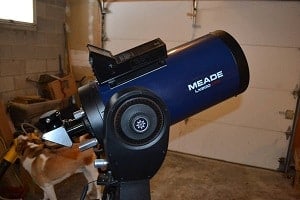
Cons:
- They have a much higher upfront cost than reflecting scopes.
- Some of its units also require occasional collimation.
Are There Better Manufacturers to Consider?
Yes, dependent on your objective use for your telescope looking for reputable telescope manufactures is key to being happy when you view. Most telescopes are made or have parts made in Taiwan and China. The difference is these manufacturers do have and standard behind the telescopes they produce. The following list is for the higher quality optics and that stand behind their product. There may be some left out, let us know if it is.
Some of the large Chinese scope manufacturers are Kunming’s United Optics and Synta, where the former is better known to make higher quality units.
Meanwhile, some of the known Taiwanese manufacturers of telescopes are William Optics and Guan Sheng Optical (GSO). Compared to Chinese manufacturers, Taiwan has typically produced a more significant quality telescope.
Here is a list of credible telescope manufacturers in reverse alphabetical order.
- Vixen Optics
- TMB Optical
- Tele Vue Optics, Inc.
- Takahashi America
- Stellarvue
- Sky-Watcher USA
- PlaneWave Instruments
- Orion Telescopes & Binoculars
- Olivon USA
- Officina Stellare
- Obsession Telescopes
- Meade Instruments Corp.
- JMI Telescopes
- iOptron
- Hyperion
- Gskyer
- Galileoscope, LLC
- Explore Scientific
- DFM Engineering, Inc.
- Ceravolo Optical Systems
- Celestron
- Borg
- AstroTelescopes
- Astro-Physics Inc.
- Astronomy Technologies
- Argus Optics
- AG Optical Systems
Now, What to Look for on That “New to You” Telescope
Before buying your new telescope, it is best for you to know which features to look for and what is considered to be good. That can get very complicated; however, we are going to highlight three main features to consider when choosing your new telescope. The three elements are aperture, mount, and eyepieces.
Below will be a further elaboration for each feature.
Aperture: The Larger, the Better
Among other features of a telescope, the aperture is the most critical part in ensuring quality image. The aperture or objective is responsible for gathering enough amounts of light to creating a crisp, clean image with finer details available of the celestial object.
The preferred and standard diameter (D) of the aperture should not be less than 70 millimeters or 2.8 inches. Its diameter is typically expressed in millimeters and seldom in inches. In case you forgot; 25.4mm = 1”. An aperture larger than 70 millimeters is most preferred to start seeing more than the moon.
70mm or less, you might as well use binoculars they are more comfortable to use and more versatile.
Check out our magnification calculator to find out if the telescope and its included package will be able to see Saturn and its rings. Free Download Here.
Telescope Mount: Sturdy and Smooth Adjustment
The mount of any telescope is typically an afterthought by most customers. It should not be, because the mount provides the overall support of your scope. Telescopes can get heavy fast, and you will need a mount with more substance than an aluminum camera tripod.
Plus, telescope mounts have two major types: the altitude-azimuth (alt-az) and the equatorial type. For an alt-az mount, it allows your scope to move sideways and up-down. Similar to how camera tripod moves with pan and tilt motion. For more on telescope mounts, check out this article.
Meanwhile, for an equatorial mount, it is designed to follow an object as the earth spins all along one axis the right ascension. The declination is the up and down movement and is to find the object compared to the horizon or so many degrees from Polaris. This type of mount is more substantial and larger than the alt-az. Likewise, before using this one, you need to align your scope with the North Star Polaris. See our article on Why You Should Know How To Find The North Star.
Furthermore, a more advanced mount with a small motor which is called a “GoTo” telescope. This one involves the use of a computer controlling system where you can make it point directly to a particular object with a push of the button. To calibrate this mount, it usually requires 2, 3, or 4 start alignments along with your present location, time, and date. To learn more about my opinion on GoTo scopes and mounts take a look at this article.
Eyepieces
This part is where you view the image and can be the most complicated because there are a lot of classifications for eyepieces. Typically if you have a Plössl you are good; however, there are like 10 different variations of a Plössl eyepiece. So, we will discuss what features to look for that help make a good eyepiece.
Rubber Eyecup: Helps with comfort for extended viewing, and perhaps faint light sources that help block. It also helps gauge your eye from your eyepiece. When you have small focal length eyepieces, and your eye is super close to the lens. Holding your head still and trying not to move more than a millimeter or two is tiring.
Quantity of Lenses: A Plössl lens made with 3 or 4 lenses is considered good quality. The multiple lenses help straighten the light back out going to the eye and help reduce chromatic aberration or distortions within the eyepiece.
Multi-Coatings: Eyepieces with multiple coatings helps protect the lens as well as reduce glare and distortions. They usually say if it is something special on it, but you can tell coatings by a hue of color as light reflects off its surface.
Field Of View: Here is a simple one, the wide the better. The normal Plössl is around 50 degrees. Getting a wider field of view, like 68 degrees, and up to 100 degrees (if you have the wallet for it) allows you to see more sky at the same magnification. It helps with finding objects or seeing large DSO’s at higher magnifications.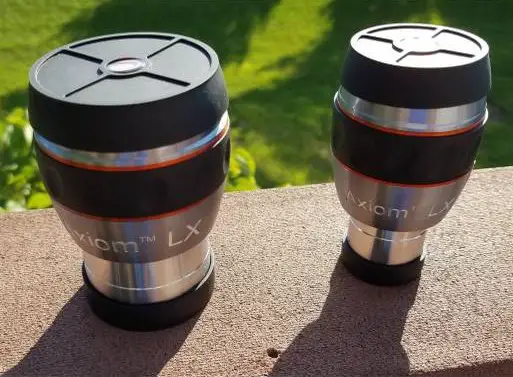
The Covers: Yes, it may sound stupid, but if you are buying a used telescope and the eyepieces do not have covers it probably means they are dirty and need to be cleaned before using. They may have been kept in a case, but unless you are getting a case, the eyepiece will get dusty dirty for you. Trying to clean a lens can be a delicate matter.
When examining the eyepiece, the lower number means higher magnification. Likewise, if you intend to buy some eyepieces, choose ones with focal lengths between 5 to 35 millimeters gives the best results. Anything outside of that range magnifies too much, or not enough. Read our article on How a Quality Barlow Lens Can Save You Money on Eyepieces.
How to Make Sure Everything is There
For you to ensure everything is complete with the telescope you are eyeing to buy, arm yourself with some checklist like this one:
Check List 1:
- Is it in my budget?
- Will it satisfy my point of study?
- Is it an acceptable style for the age of the user?
Number one should be easy, and we won’t go into detail about it. Number 2, should be a telescope that falls within your interest. For example; if you want to take astrophotography of deep space objects, a Dobsonian, or a large reflector style, or even a Schmidt Cassegrain on an equatorial mount, or a GoTo mount will be needed.
If you are just buying to see if a child is interested, a 70mm to a 100mm refractor style on an alt-azimuth mount will suffice. It is sturdy and typically ready to use. A point and view type of scope. A good pair of 15×70 binoculars will allow excellent views of the moon and close planets as well. You can add a tripod mount and add them to a camera stand making binoculars a viable option here.
We touched on number three above a little with how sturdy and straightforward it is for a child. Broke down more, it basically means, if for a child under 12. Binoculars or a refractor style is best. There is no real maintenance, and they are rugged enough for little bumps from time to time. Twelve and up they start to have the responsibility to handle a reflector scope and probably can collimate it once shown. Of course, an adult is hopefully responsible for any telescope, the budget and ability to collimate may come into play.
Here are some quick little tables to help illustrate what we are saying.
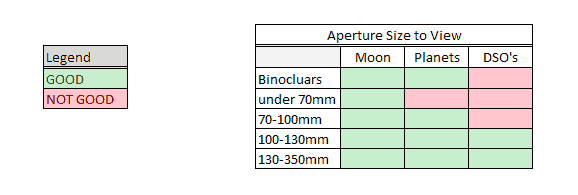


You made it past your first checklist. Now let’s make a second checklist. Some of the essential things you can note in your second checklist are the manufacturer or brand of the telescope, type of telescope, aperture diameter, mount type, magnification ability, and your price range. It is always best to shop and search online for the price range and reviews of the telescope you wish to have. Here is a second checklist you can download.
So, if it passed the mustard so far, now it is time to check it out. Go get a hold of it. Try it out, make sure it will work for you.
Hands-on checking
- Check the eyepieces, are they good brand and quality? Does it come with suitable sizes?
- On a refractor, check the lenses, look at them, you are looking for dirt, and scratches. Take a LED flashlight along to see how it reacts through, and on the lenses.
- On a reflector, check for dirt and scratches on the mirrors.
- A compound check is just combining both refractor and reflector checking.
- Put a high number eyepiece (like a 25mm or higher) in and try it out on something in the distance. You should be able to focus it to a crystal clear view. Remember a hot, hazy day will not be as clear, because you are magnifying humidity.
- Set it up in the mount; try the mount out, the slow control knobs should be smooth and easy to turn. Also, look for surface rust from storage in a basement.
- The focus knobs should move like silk to bring the object into focus. Change eyepieces to try another focus point.
- Nothing should be loose in the mount, no wobble, or jiggles. On an equatorial mount, make sure it will be easy to level.
- GoTo telescopes offer a real challenge because they have technology tied with it. Make sure it is a real GoTo scope (it will have a hand controller) and make sure the battery compartment is not corroded. Bring batteries and test it! This is where obsolete parts can pop up within 4 or 5 years. Check the manufacture website to see if parts are available still.
When doing your calculations for the power of the scope, always remember the rule of thumb – the ideal maximum power of any scope is the aperture’s diameter times 2 in millimeters, and if in inches multiply the diameter by 50.
OK, everything has checked out, the only thing left is the price.
How to Compare the Asking Price to a New Scope
Typically, the price of any telescope dramatically depends on the features and benefits it can offer to its prospective clients. In layman, you always get what you pay for, and you still need to have that concept to avoid regrets.
There are various price ranges for telescopes, and each has its particular features you might be looking for. The best advice we can share is for you to do market research or price comparison of the telescope with the specific features you want. Amazon is an excellent place to compare new prices and availability. Check current prices on Amazon now.
The typical price ranges of new telescopes on the market are $75 to $200, $200 to $400, $400 to $600, and then you have the expensive ones higher than $600. When buying used, you can roughly figure about half of the new price as mentioned.
The typical situation is if you are starting out your hobby in observational astronomy; buy the cheap one first to familiarize yourself with the tool. Hopefully, this article has deterred this approach. If you know you want to study DSO’s with $100 to spend, you will be discouraged. I say save up to get what you need or get binoculars to keep the interest until you have enough. This is what happened to me as a kid of about twelve.
I got a telescope at twelve, and could only see the moon. You see, it was an alt-azimuth mount, and when you powered up, you could not track the object. The 4mm eyepiece had an imperfection in it. I was disappointed and did not get back into it until 43 years later.
What Age is Too Old for a Previously Owned Telescope?
The lifespan of a telescope greatly depends on how the previous owner used and maintained its condition. For a compound and reflecting telescope, it can lose its reflective abilities by 1 percent or so every year mostly from dirt accumulation, and light scuffing from cleaning. Consequently, to maintain an excellent viewing of the sky, you may need to do a re-surfacing of its mirrors when necessary.
I wouldn’t worry about mirror derogation so much, the age might leave obsolete parts, on the mount or the scope. This especially comes into play with GoTo telescopes as mention above.
You can also ask the previous owner on what their maintenance practices were for keeping the telescope in good condition.
Best Places to Look for a Good Used Telescopes
There are several places to shop and buy a used first telescope that is great for observational astronomy.
Online: eBay, High Point Scientific, Craigslist, Facebook Marketplace, and Letgo.
Local Astronomy Clubs: Check online for local astronomy clubs. Often once you join, sometimes they offer loaners.
Some Popular Retail Shops Online: see list below.
- High Point Scientific
- 422 Route 206, Montague, NJ 07827, USA
- Phone: +1 800-266-9590
- Land, Sea and Sky Co.
- 1925A Richmond Ave, Houston, TX 77098, USA
- Phone: +1 713-529-3551
- Cloud Break Optics
- 2821 NW Market St g, Seattle WA 98107, USA
- Phone: +1 206-327-9826
- Skies Unlimited LLC
- 46 Glocker Way, Pottstown, PA 19465, USA
- Phone: +1 888-947-2673
- Orion’s Product Wizard – Helps you find the right product
” data-wplink-url-error=”true”>Orion Telescopes & Binoculars
- 89 Hangar Way, Watsonville, CA 95076, USA
- Phone: +1 831-763-7000
I like eBay because of buyer protection is included. With the information you have learned here in this article, so you can arm yourself to find something that should fit the bill.
With eBay, I only go 30 to 40 percent of the new price for a bit of padding in case I am wrong.
Check out telescopes on eBay here.
Need More?
It can get pretty involved based on all the parameters involved with the types of telescopes and all the things to view. You can, however, find good deals here and there. I have bought all my telescopes second hand since getting back into the hobby, and I could basically sell them for at least what I paid I figure. And that is the main reason to buy a good used telescope.
However, as I keep moving forward in this hobby I will get impatient and want what I am tired of waiting for, I will go new.
If you liked this article, you might want to check out these articles as well.
The Reason, Planets, Appear Black and White in a Telescope?
